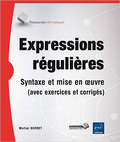GNU/Linux man pages
Livre :
Expressions régulières,
Syntaxe et mise en oeuvre :


Unix |
Unix v7 |
|
 |
ps(1) |
 |
ps − process status
ps [ aklx ] [ namelist ]
Ps prints certain indicia about active processes. The a option asks for information about all processes with terminals (ordinarily only one’s own processes are displayed); x asks even about processes with no terminal; l asks for a long listing. The short listing contains the process ID, tty letter, the cumulative execution time of the process and an approximation to the command line.
The long listing is columnar and contains
|
F |
Flags associated with the process. 01: in core; 02: system process; 04: locked in core (e.g. for physical I/O); 10: being swapped; 20: being traced by another process. | ||
|
S |
The state of the process. 0: nonexistent; S: sleeping; W: waiting; R: running; I: intermediate; Z: terminated; T: stopped. | ||
|
UID |
The user ID of the process owner. | ||
|
PID |
The process ID of the process; as in certain cults it is possible to kill a process if you know its true name. | ||
|
PPID |
The process ID of the parent process. | ||
|
CPU |
Processor utilization for scheduling. | ||
|
PRI |
The priority of the process; high numbers mean low priority. | ||
|
NICE |
Used in priority computation. | ||
|
ADDR |
The core address of the process if resident, otherwise the disk address. | ||
|
SZ |
The size in blocks of the core image of the process. | ||
|
WCHAN |
The event for which the process is waiting or sleeping; if blank, the process is running. | ||
|
TTY |
The controlling tty for the process. | ||
|
TIME |
The cumulative execution time for the process. |
The command and its arguments.
A process that has exited and has a parent, but has not yet been waited for by the parent is marked <defunct>. Ps makes an educated guess as to the file name and arguments given when the process was created by examining core memory or the swap area. The method is inherently somewhat unreliable and in any event a process is entitled to destroy this information, so the names cannot be counted on too much.
If the k option is specified, the file /usr/sys/core is used in place of /dev/mem. This is used for postmortem system debugging. If a second argument is given, it is taken to be the file containing the system’s namelist.
/unix system
namelist
/dev/mem core memory
/usr/sys/core alternate core file
/dev searched to find swap device and tty names
kill(1)
Things can
change while ps is running; the picture it gives is
only a close approximation to reality.
Some data printed for defunct processes is irrelevant
 |
ps(1) |  |